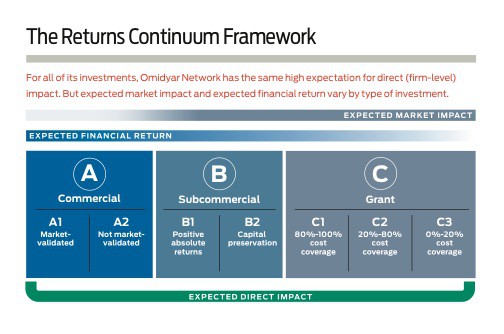Omidyar Network releases returns framework based on $1B and 12 years of investing in social entrepreneurs and nonprofits.
Omidyar Network releases returns framework based on $1B and 12 years of investing in social entrepreneurs and nonprofits
Redwood City, California, November 15, 2016 – Based on $1B and 12 years of impact investing experience, Omidyar Network today published a new framework to help other impact investors evaluate the financial and social impact of their investments. The report lays out a continuum that includes commercial investments, subcommercial investments, and philanthropic grants.
“This report is intended to move impact investing beyond the long-standing and unproductive debate that impact investors can have either financial return or social impact, but not both,” said Matt Bannick, managing partner at Omidyar Network. “In our experience, that is a false choice—in fact, impact investing opportunities fall along a spectrum of financial and social returns.”
The report, “Across the Returns Continuum,” appears in the Winter 2017 issue of the Stanford Social Innovation Review. It introduces Omidyar Network’s impact investment framework and details the conditions under which Omidyar Network accepts lower financial returns in exchange for greater social impact. The framework classifies investments into three categories:
1. Commercial Investments. Commercial investments are expected to deliver both positive social impact and strong financial returns.
2. Subcommercial Investments. In order for Omidyar Network to make an investment that is unlikely to generate commercial returns, the firm requires that its social impact extend beyond its customers to the broader marketplace, such as:
- Pioneering a new business model that has the potential to create an entirely new market with broad social impact.
- Providing industry infrastructure that is necessary for markets to develop effectively.
- Influencing government policy or sparking debate on important issues in a way that helps shape market conditions.
3. Philanthropic Grants. These grants are not expected to produce a financial return, but they are expected to have high social impact. Grants are awarded to organizations according to their ability to become self-sufficient, through approaches ranging from producing zero revenue to covering up to 100 percent of their costs.

The Across the Returns Continuum report is available on Stanford Social Innovation Review’s website at http://www.ssir.org/articles/entry/across_the_returns_continuum.
